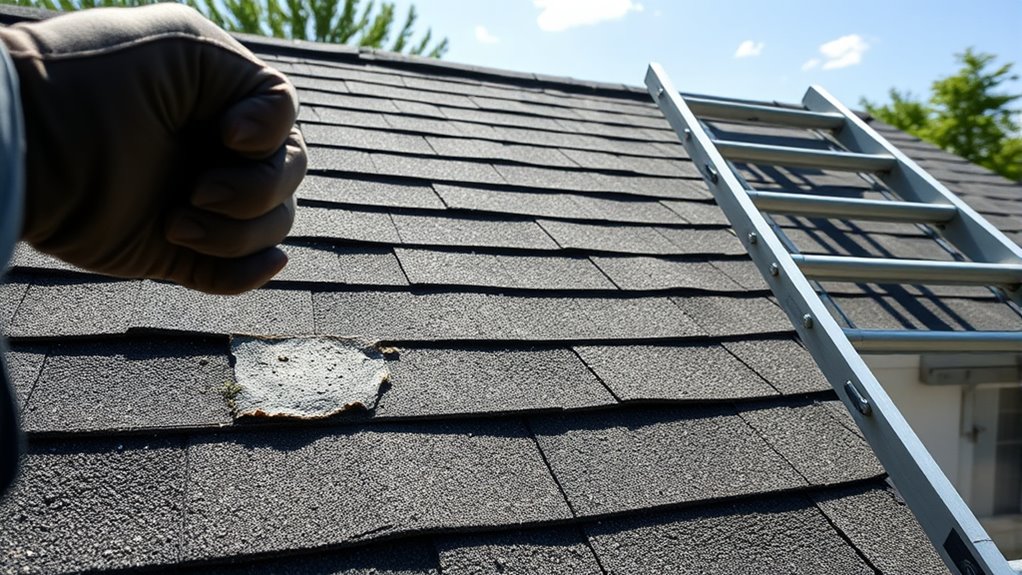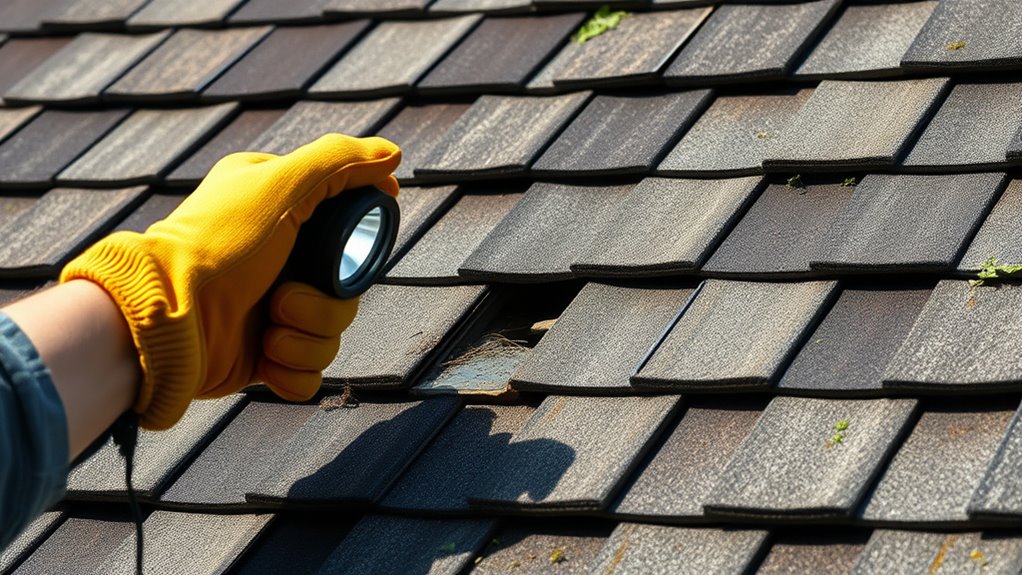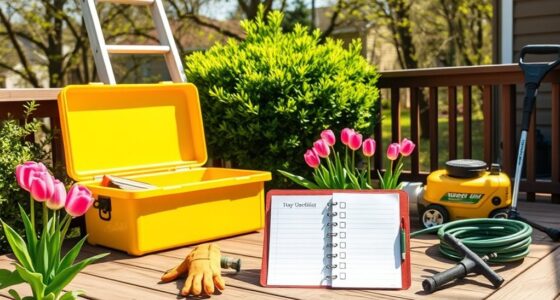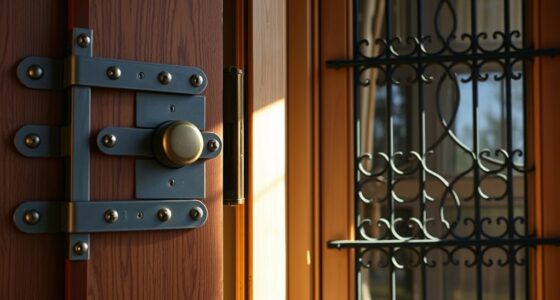To check for leaks and damage, regularly inspect both inside and outside your roof. Inside, look for water stains, sagging ceilings, or musty smells. Outside, examine shingles, flashing, and seams for signs of damage or missing pieces. Clear debris from gutters and drains, and test for leaks by using a hose on suspected areas. Catching issues early can save you money, and there’s more to learn if you keep exploring this essential maintenance.
Key Takeaways
- Regularly inspect your roof twice a year for signs of damage, leaks, and wear using proper safety equipment.
- Examine interior ceilings and walls for water stains, sagging, or mold that indicate leaks.
- Check for missing, broken, or damaged shingles, tiles, or membrane sections, and remove debris like leaves and branches.
- Inspect flashing around vents, chimneys, and skylights for rust, cracks, or gaps, and repair as needed.
- Clean gutters and roof drains regularly to ensure proper drainage and prevent water pooling or structural damage.

Are you confident your roof is in good shape? Regular maintenance is essential to catch problems early and prevent costly repairs down the line. One of the most effective ways to do this is by checking for leaks and damage consistently. You should aim to inspect your roof at least twice a year—preferably in spring and fall—so you can identify issues before they worsen. During these inspections, gather a ladder, gloves, a safety harness, and a flashlight. Be sure to take your time to examine all visible areas carefully. If you’re unsure about the process or your roof’s complexity, consider hiring a professional for a thorough inspection. Their expertise can reveal hidden problems and give you peace of mind, though it does come with a cost that varies depending on your location and roof size.
Start your check by looking for signs of leaks inside your home, such as water stains on ceilings, sagging areas, or a musty smell that indicates hidden moisture. Outside, use a hose to simulate rain and spray water over your roof, especially around vulnerable spots like flashing and seams. Watch for any drips or discoloration inside, which signals a leak. Address leaks immediately by sealing gaps with appropriate materials, such as roof sealants, or repairing damaged flashing. Prompt repairs prevent water from seeping further into your home, which can cause structural damage or mold growth.
Next, inspect the roof surface itself. Look for damaged or missing shingles, tiles, or membrane sections. Clear debris such as leaves and branches, as these can trap moisture and accelerate deterioration. Keep moss or algae growth under control because they can weaken your roof material over time. After severe weather events like hail or high winds, recheck your roof for damage, as these can compromise the surface. Early detection of wear and tear allows you to replace or repair damaged sections before they lead to leaks or bigger problems.
Don’t forget to examine flashing—the metal strips around vents, chimneys, skylights, and other roof penetrations. Rust, cracks, or gaps in flashing can allow water to seep into your home. Repair or replace damaged flashing promptly with matching materials to maintain a waterproof seal. Regularly check seals around vents and other penetrations for deterioration or gaps, and reseal if necessary. Keeping these components in good condition is crucial for preventing leaks.
Finally, ensure your roof’s drainage system works smoothly. Clear gutters and roof drains of debris, and check for standing water or pooling areas that indicate poor drainage. Clogged drains can cause water to back up, leading to structural damage. Schedule annual maintenance to keep water flowing freely, helping your roof stay dry and durable. Additionally, incorporating digital tools for monitoring can help you stay proactive in roof maintenance. Taking these simple steps consistently can extend your roof’s lifespan, protect your investment, and keep your home safe and dry.
Frequently Asked Questions
How Often Should I Schedule Professional Roof Inspections?
You should schedule professional roof inspections at least twice a year, preferably in spring and fall. If your roof is over ten years old, consider annual inspections, and semi-annual if it’s over 20. After severe weather events, get an inspection to catch hidden damage. Regular inspections help prevent leaks, structural issues, and extend your roof’s lifespan, ensuring safety and saving you money on costly repairs down the line.
What Are the Signs of Hidden Roof Damage?
Hidden roof damage can be like an iceberg lurking beneath the surface. You might notice water stains on ceilings, sagging attic floors, or daylight shining through rafters—silent signs of trouble. Moss, cracked shingles, or rusted flashing also whisper warnings. Keep an eye out for increased energy bills or musty attic smells. Addressing these early clues saves you from costly repairs later, so stay vigilant and inspect regularly.
Can Minor Leaks Be Repaired Without Professional Help?
Yes, minor leaks can often be repaired without professionals. You should start by inspecting your roof for loose, cracked, or missing shingles, especially around vents, chimneys, and flashing. Use the right tools like a pry bar, sealant, and matching shingles. Carefully lift shingles, replace damaged ones, and seal edges with roofing caulk. Always guarantee safety, and avoid fixing large or complex leaks that need professional expertise.
What Roofing Materials Are Most Durable Against Weather?
Imagine your roof facing a fury of storms—hail, snow, relentless rain—yet some materials stand unscathed like superheroes. Metal roofing resists all weather conditions, lasting decades with ease. Slate shingles endure a century of harshness, while composite shingles shrug off impacts and wind. These materials are built like armor, protecting your home from nature’s worst, ensuring safety and longevity in even the most brutal weather battles.
How Does Roof Ventilation Impact Leak Prevention?
You might wonder how roof ventilation impacts leak prevention. Proper ventilation helps remove moist air from your attic, reducing condensation that can lead to leaks. It also prevents ice dams in winter, which cause water seepage. By maintaining good airflow, ventilation keeps your roof dry, minimizes moisture buildup, and protects your roof’s structure. Ultimately, good ventilation reduces the risk of leaks, extending the lifespan of your roof and safeguarding your home.
Conclusion
Regular roof checks might seem like a hassle, but they’re key to avoiding costly repairs down the line. By catching leaks and damage early, you save money and extend your roof’s lifespan. Think you don’t have time? Even a quick inspection can make a huge difference. Don’t wait until a small issue turns into a big problem. Take a few minutes now—your roof (and wallet) will thank you later!










